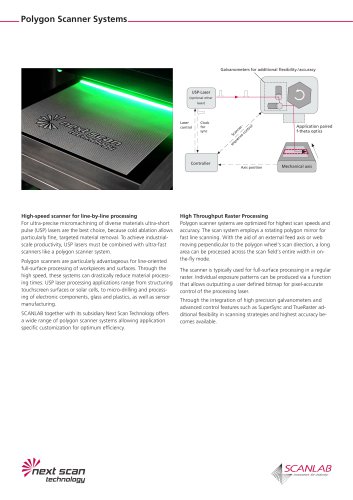
Catalog excerpts

Automatic Self-Calibration Laser scan solutions from SCANLAB provide highly dynamic deflection and positioning of laser beams - which allows workpieces to be processed flexibly, Along with speed, long-term repeatability is very important for many applications - for example, rapid prototyping in which the processing operation can span many SCANLAB offers a self-calibration option for scan heads that are targeted for such applications. The scan head is thereby equipped with an additional internal sensor system. This reference system makes it possible to calibrate the position detectors desired point of time. If high repeatability over a long time is required, then drift effects - which may be caused, for example, by fluctuations liably compensated with Automatic Self- Positioning accuracy is thus maintained over long periods of time. Remaining long- term drift effects are of the same order of magnitude as short-term repeatability. During calibration, the scan head auto- matically seeks several reference positions within the scannable area that are defined by the internal sensor system. The seek values are determined and compared with fixed reference values. From the resulting deviations, offset and gain compensation These compensation factors are immedi- ately made available for use in all future positioning tasks. The calibration routine can be initiated via a simple RTC® command that can be called any time re-calibration is deemed appropri- ate. During the calibration routine, the la- ser is switched off and no other commands are transferred to the scan head. The entire calibration procedure takes place in only 5 System Requirements • Digital scan system with self-calibration option • RTC® PC interface board Internal sensor system for automatic self- Available for scan systems with apertures High long-term repeatability achievable Reliable compensation of long-term and temperature drift-effects Simple operation via an RTC® PC interface board Typical Optical Long-Term Behavior with the Self-Calibration Option Remaining offset drift Remaining gain drift Remaining long-term < 20 |_irad drift over 8 hours (at constant environmental conditions)_ Typical Applications: • Rapid manufacturing • Deep engraving • Laser measurement techniques SCANLAB AG ■ Siemensstr. 2a ■ 82178 Puchheim ■ Germany SCANLAB America, Inc. ■ 100 Illinois St ■ St. Charles, IL 60174 ■ USA
Open the catalog to page 1All SCANLAB GmbH catalogs and technical brochures
-
smart scanning
6 Pages
-
intelliSCAN IV
4 Pages
-
excelliSHIFT
1 Pages
-
dynAXIS 421
4 Pages
-
powerSCAN II 50i
2 Pages
-
Polygon Scanner Systems
2 Pages
-
palmSCAN
2 Pages
-
laserDESK
4 Pages
-
intelliWELD II, intelliWELD
4 Pages
-
basiCube
2 Pages
-
basiCube14
2 Pages
-
rtc4
2 Pages
-
powerscanpowerscani
4 Pages
-
intelliscaniii
2 Pages
-
intelliscanse
2 Pages
-
intelliSCAN+intelliScande
4 Pages
-
hurryscaniiihurryscan
4 Pages
-
high-speed z axis
1 Pages
-
dynaxis
2 Pages
-
CollimationModul
2 Pages
-
excelliSCAN scan system
4 Pages
-
Company Profile SCANLAB AG
24 Pages
-
SCANalign Vision System
4 Pages
-
basiCube 10 scan head
2 Pages
-
hand-held scan-device
2 Pages
-
universal and compatible
4 Pages
-
intelliSCAN III Scan Heads
2 Pages
-
Galvanometer Scanners
2 Pages
-
Scancube III Scan Heads
2 Pages
-
Camera Adapter
2 Pages
-
laserDESK Software
4 Pages
-
RTC5 control boards
2 Pages
-
Scan System "powerSCAN"
4 Pages
-
Scan-System "intelliWELD"
4 Pages
-
2D Scan Heads "hurrySCAN"
4 Pages
Archived catalogs
-
Camera Adapter
2 Pages
-
RTC®5
2 Pages
-
RTC®3, RTC®4
2 Pages
-
powerSCAN 33
2 Pages
-
intelliWELD® 30 FC
2 Pages
-
intelliSCAN®
2 Pages
-
SCANcube® 7, 8.5, 10, 14
2 Pages

























































